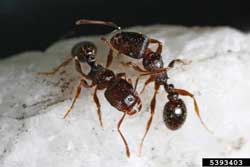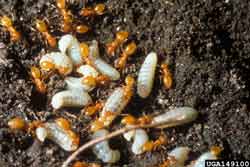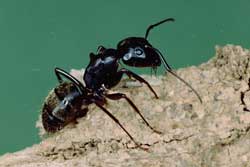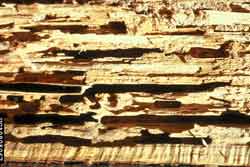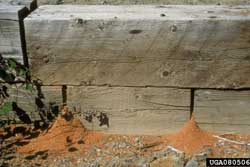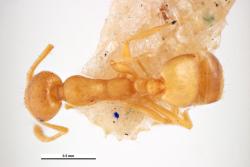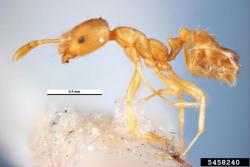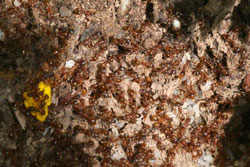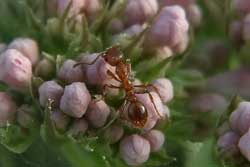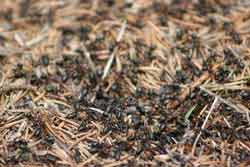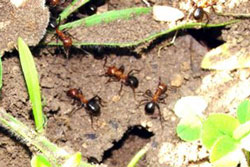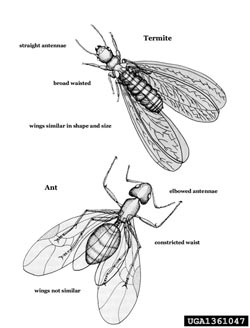Ants
On this Page:
Ants are social insects that live in colonies or nests usually located in the soil near the house foundation, under concrete slabs, in crawlspaces, in structural wood, in the yard or garden, in trees and in other protected places. Some ants are a nuisance, others can cause structural (economic) damage or health risks to humans.
Ants Commonly Found In and Around Structures
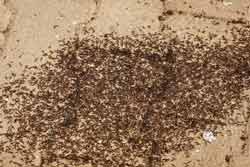
Infestation of pavement ants (Tetramorium caespitum). They are found outdoors unders stones, in pavement cracks and in crevices of masonry and woodwork.
Carpenter Ants
Black—Componotus pennyslvanicus
Red—Componotus ferrugineus
Pharaoh Ant—Monomorium pharaonis
Pharaoh ants are light yellow to reddish brown and almost transparent. Workers are about 1/16-inch long. They eat a wide variety of foods, especially those containing fat, grease or sugar, but they will also eat many things other ants rarely consume, such as toothpaste and soap. They are considered one of the most difficult ants to control and pesticides can cause them to bud, creating new colonies.
Ants Found in Lawns
European Fire Ant—Myrmica rubra
Myrmica rubra is not native to the United States. It has become a significant pest because these aggressive, stinging ants interfere with people's use and enjoyment of their properties, gardens and parks. When disrupted, the ants will deliver a painful sting which has in a few cases produced severe allergic reactions to the venom including anaphylactic shock.
Allegheny Mound Ant—Formica excectoides
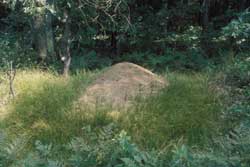
This ant normally lives outdoors with nests consisting of huge conical mounds, sometimes measuring nearly 3 feet high by 6 feet in diameter.
Ants vs. Termites
People often confuse winged termites with ants, which often swarm at the same time of year. To differentiate, look at the midsection, antennae and wings.
Midsection: The ants have “wasp waists.” Between the thorax and the abdomen is a narrow connection in ants, just like with wasps. The termites do not have this slender waist. Their width continues, gradually increasing, from the thorax to the abdomen.
Antennae: Termites have straight antennae; on ants the antennae have elbows.
Wings: All four of the wings of a termite are about the same length. The two rear wings of a flying ant are shorter than the front wings.
Click on images to view full-size
Ants—Identification and Control Information
- All About Ants—Cornell College of Agriculture & Life Sciences
- Integrated Pest Management for Home Gardeners and Landscape Professionals: Ants (PDF)—University of California
- Key to Identifying Common Household Ants (PDF)—University of California
- Ants in Houses (PDF)—Cornell University Insect Diagnostic Laboratory
- Entomological Notes: Pavement Ant (PDF)—Penn State College of Agricultural Sciences Cooperative Extension
- Pavement Ants (Identification, Biology, and Control) (PDF)—Environmental Health & Safety, Harvard University
- Ant Baits: A Least-Toxic Control (PDF)—University of Nebraska Cooperative Extension
- Entomology Insect Information Series: Acrobat Ants (PDF)—Clemson University Cooperative Extension Service
- Tips for Managing Nuisance Ants (PDF)—Maine Integrated Pest Management Council
Carpenter Ants—Identification and Control Information
- Carpenter Ants (Identification, Biology, and Control) (PDF)—Harvard University
- Carpenter Ants in Maine]—Maine Department of Agriculture, Conservation and Forestry, Maine Forest Service
- Insects From Firewood]—Maine Department of Agriculture, Conservation and Forestry, Maine Forest Service
- Fact Sheet: Carpenter Ants (PDF)— Cornell University Cooperative Extension
- Fact Sheet with Description and Management Options—University of Maine Cooperative Extension
- Entomological Notes: Carpenter Ants (PDF)—Penn State College of Agricultural Sciences Cooperative Extension
- Tips for Managing Carpenter Ants (PDF)—Maine Integrated Pest Management Council
Pharaoh Ants—Identification and Control Information
- Pharaoh Ants—University of Florida
Fire Ants—Identification and Control Information
- European Fire Ant: A New Invasive Insect in Maine (PDF)—University of Maine Cooperative Extension
- Distribution of an Invasive Ant, Myrmica rubra in Maine (PDF)—Journal of Economic Entomology
Allegheny Mound Ant
- Beneficial Insect Series 1: The Allegheny Mound Ant—University of Maine Cooperative Extension
- Identification Resource—Iowa State University Entomology
[Photos, left to right: (pavement ants) Joseph Berger, Bugwood.org; (pavement ants) Joseph Berger, Bugwood.org; (larger yellow ants) Howard Ensign Evans, Colorado State University, Bugwood.org; (black carpenter ant) Clemson University - USDA Cooperative Extension Slide Series, Bugwood.org; (carpenter ant damage) R. Werner, USDA Forest Service, Bugwood.org; (carpenter ant damage) Edward H. Holsten, USDA Forest Service, Bugwood.org; (European fire ants); ((European fire ant); (Allegheny mound ants) Catherine Herms, The Ohio State University, Bugwood.org; (Allegheny mound ants); (Allegheny mound ants) Steve Wilson; (ant vs. termite diagram) USDA Forest Service Archive, USDA Forest Service, Bugwood.org; (Pharaoh ants) Pest and Diseases Image Library, Bugwood.org]
